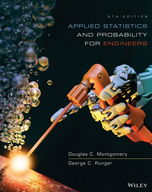Ch 7.3 - 38E
Chapter 7, Problem 38E(choose chapter or problem)
Two different plasma etchers in a semiconductor factory have the same mean etch rate \(\mu\). However, machine 1 is newer than machine 2 and consequently has smaller variability in etch rate. We know that the variance of etch rate for machine 1 is \(\sigma_{1}^{2}\), and for machine 2, it is \(\sigma_{2}^{2}=a \sigma_{1}^{2}\). Suppose that we have \(n_{1}\) independent observations on etch rate from machine 1 and \(n_{2}\) independent observations on etch rate from machine 2.
(a) Show that \(\hat{\mu}=\alpha \bar{X}_{1}+(1-\alpha) \bar{X}_{2}\) is an unbiased estimator of \(\mu\) for any value of α between zero and one.
(b) Find the standard error of the point estimate of \(\mu\) in part (a).
(c) What value of α would minimize the standard error of the point estimate of \(\mu\)?
(d) Suppose that \(a=4\) and \(n_{1}=2 n_{2}\). What value of α would you select to minimize the standard error of the point estimate of \(\mu\)? How “bad” would it be to arbitrarily choose
\(\alpha=0.5\) in this case?
Equation Transcription:
Text Transcription:
mu
sigma_1^2
sigma_2^2=a sigma_1^2
n_1
n_2
mu hat=alpha X bar_1+(1-alpha)X bar_2
mu
alpha
mu
alpha
mu
a=4
n_1=2n_2
alpha
mu
alpha=0.5
Unfortunately, we don't have that question answered yet. But you can get it answered in just 5 hours by Logging in or Becoming a subscriber.
Becoming a subscriber
Or look for another answer
